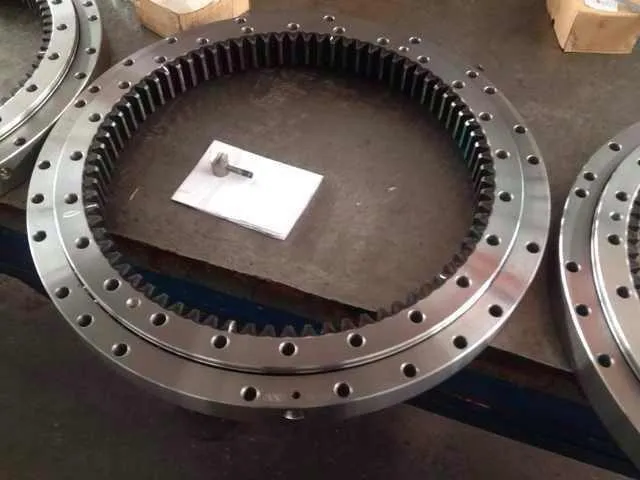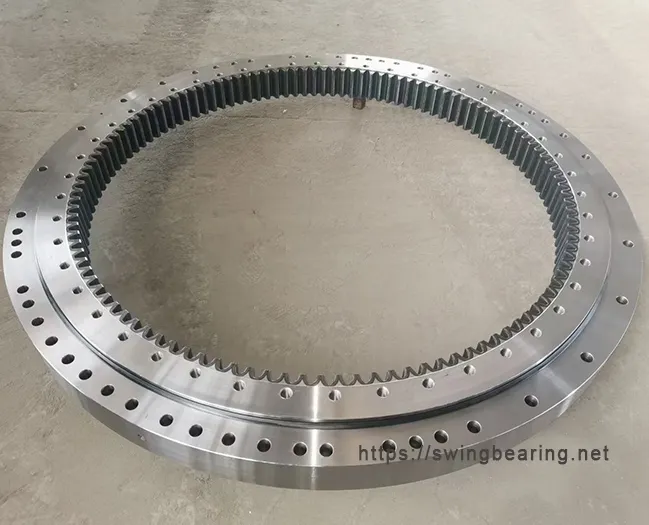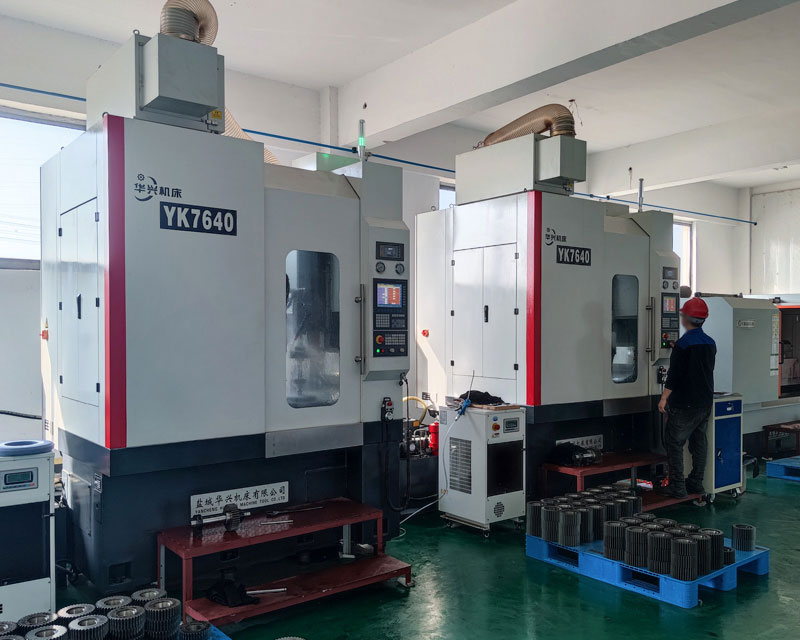
Slewing bearings are critical components in various heavy-duty machinery, ensuring smooth and efficient rotational movement. Their performance and longevity are influenced by both the inherent quality of the product and the maintenance practices employed during their service life. It is often said that a slewing bearing’s durability depends 30% on its quality and 70% on maintenance. One of the most common issues faced by slewing bearings is raceway failure, which manifests through symptoms such as increased clearance, oil leakage, sticking, abnormal noises, and the presence of iron particles or even larger iron fragments. In this comprehensive exploration, we will delve into the four primary forms of 旋回ベアリング raceway failure: wear, plastic deformation, surface peeling, and corrosion/pitting. We will discuss their causes, effects, and solutions, emphasizing the importance of regular maintenance and proper handling to extend the service life of these vital components.
Raceway wear is a predominant failure mode in slewing bearings, resulting from the relative sliding friction between surfaces that causes continuous material degradation. This wear can be categorized into two types: normal wear and abnormal wear. Normal wear is a gradual process that occurs over the bearing’s service life, leading to an increase in clearance and changes in the raceway’s surface profile. This type of wear is expected and can be managed with regular maintenance and monitoring.
Abnormal wear, on the other hand, is indicative of underlying issues related to manufacturing defects, the quality of standard parts, lubricant inefficiencies, or poor maintenance practices. For instance, improper heat treatment during manufacturing can lead to insufficient hardness, making the raceway surface more susceptible to wear. Similarly, the use of substandard lubricants can fail to provide adequate protection against friction and wear.

The effects of raceway wear are multifaceted. As the wear progresses, the fit clearance increases, compromising the bearing’s ability to maintain its rotational accuracy. This degradation can lead to increased vibration and noise during operation, affecting the overall performance and efficiency of the machinery. In severe cases, excessive wear can cause the bearing to fail completely, resulting in operational downtime and costly repairs or replacements.
Furthermore, the change in the raceway’s surface profile due to wear can disrupt the lubrication film between the rolling elements and the raceway, exacerbating the wear process. This situation creates a vicious cycle where increased wear leads to further deterioration, significantly shortening the bearing’s service life.
Addressing raceway wear involves a combination of preventive measures and timely interventions. Regular inspections are crucial to detect early signs of wear and take corrective actions. Utilizing high-quality lubricants that are appropriate for the specific operational conditions can significantly reduce friction and wear. Additionally, ensuring proper installation and alignment of the bearing can prevent uneven load distribution that accelerates wear.
In cases where abnormal wear is detected, it is essential to identify and rectify the root cause, whether it is a manufacturing defect, a lubricant issue, or a maintenance lapse. Replacing worn-out bearings promptly can prevent further damage to the machinery and reduce the risk of catastrophic failure.

Plastic deformation in slewing bearings occurs when external forces cause local plastic flow or overall deformation of the raceway surface. This deformation can manifest as twisted or warped cages, distorted raceways, or even indents on the surface. Plastic deformation is often a result of overloading, improper handling, or insufficient material hardness.
One common scenario leading to plastic deformation is the application of excessive loads beyond the bearing’s rated capacity. This situation can occur due to sudden impacts, high operational loads, or improper installation practices that subject the bearing to undue stress. Additionally, if the bearing material lacks adequate hardness or toughness, it becomes more susceptible to deformation under load.
The presence of plastic deformation significantly impairs the bearing’s functionality. Deformed raceways disrupt the smooth rolling motion of the bearing elements, leading to increased friction, heat generation, and noise. This situation not only affects the bearing’s performance but also accelerates wear and tear on other components, leading to a cascade of mechanical issues.
Furthermore, plastic deformation can lead to misalignment and uneven load distribution, exacerbating the stress on certain areas of the raceway. This localized stress concentration can cause further deformation and potentially lead to catastrophic failure if not addressed promptly.
Preventing plastic deformation involves ensuring that the bearing is operated within its rated load capacity and that proper installation practices are followed. Using materials with high hardenability and toughness can enhance the bearing’s resistance to deformation. Regular inspections can help identify early signs of deformation, allowing for timely intervention.
If plastic deformation is detected, it is crucial to assess the extent of the damage and determine whether the bearing can be repaired or if it needs to be replaced. In some cases, reworking the raceway surface to restore its profile may be possible, but this should be done with caution to avoid further compromising the bearing’s integrity.
Surface peeling, also known as spalling, is a form of raceway failure characterized by the flaking or detachment of the hardened surface layer. This issue often arises due to inadequate hardening depth, narrow hardness transition zones, or improper heat treatment during manufacturing. Excessive axial loads, poor lubrication, misalignment, and high impact loads during operation or installation can also contribute to surface peeling.
The primary cause of surface peeling is contact fatigue, which occurs when repeated stress cycles exceed the material’s fatigue limit. This situation leads to the initiation and propagation of cracks within the hardened layer, eventually causing the surface to peel away.
Surface peeling severely impacts the bearing’s performance and longevity. The detached particles can contaminate the lubricant, leading to increased friction and wear on other bearing components. This situation creates a cycle of deterioration that accelerates the bearing’s overall failure.
The presence of peeled surfaces also disrupts the smooth rolling motion of the bearing elements, causing increased vibration, noise, and heat generation. This condition affects the bearing’s rotational accuracy and can lead to operational inefficiencies and potential machinery downtime.
Preventing surface peeling involves ensuring proper heat treatment and hardening processes during manufacturing to achieve an adequate hardening depth and uniform hardness distribution. Selecting materials with appropriate fatigue resistance and toughness is also crucial.
Regular lubrication and proper alignment during installation can help minimize the risk of surface peeling. If peeling is detected, it is essential to assess the severity and determine whether the bearing can be repaired or needs replacement. In some cases, re-hardening the surface or replacing the bearing with a higher-quality component may be necessary to restore optimal performance.
Corrosion and pitting are common failure modes in slewing bearings caused by chemical or electrochemical reactions between the metal surface and the environmental medium. This damage often manifests as rust on internal bearing surfaces and can be triggered by factors such as the intrusion of corrosive media, moisture condensation, electrical sparks, and micro-vibrations.
There are three primary types of corrosion: chemical corrosion, electrochemical corrosion, and micro-vibration corrosion. Chemical corrosion occurs due to direct chemical reactions with environmental agents, while electrochemical corrosion involves electrochemical reactions facilitated by the presence of an electrolyte. Micro-vibration corrosion, also known as fretting corrosion, occurs due to small oscillatory movements between contacting surfaces.
Corrosion and pitting compromise the bearing’s structural integrity and performance. Corroded surfaces lead to increased friction and wear, affecting the smooth operation of the bearing. Pitting, characterized by small cavities or craters on the raceway surface, can disrupt the rolling motion and lead to increased noise, vibration, and heat generation.
The presence of corrosion and pitting also reduces the bearing’s load-carrying capacity and fatigue resistance, increasing the risk of catastrophic failure. In severe cases, extensive corrosion can render the bearing unusable, necessitating replacement.
Preventing corrosion and pitting involves implementing proper sealing and lubrication practices to protect the bearing from environmental contaminants. Using corrosion-resistant materials and coatings can enhance the bearing’s durability. Regular inspections and maintenance are crucial to detect early signs of corrosion and take corrective actions.
If corrosion or pitting is detected, it is essential to assess the extent of the damage and determine whether the bearing can be repaired or if it needs to be replaced. In some cases, reworking the raceway surface and applying protective coatings can restore functionality. However, replacing the bearing with a higher-quality component may be necessary to ensure long-term reliability.
Slewing bearing raceway failures can significantly impact the performance and longevity of heavy-duty machinery. Understanding the causes and effects of wear, plastic deformation, surface peeling, and corrosion/pitting is essential for implementing effective preventive measures and timely interventions. Regular inspections, proper maintenance, and the use of high-quality materials and lubricants are crucial for ensuring optimal bearing performance and extending service life. By addressing these issues proactively, operators can minimize downtime, reduce maintenance costs, and enhance the overall efficiency and reliability of their equipment.
Q1: What are the primary causes of raceway wear in slewing bearings?
A1: The primary causes of raceway wear in slewing bearings include relative sliding friction between surfaces, inadequate lubrication, manufacturing defects, and improper maintenance practices. Wear can be categorized into normal wear, which occurs gradually over the bearing’s service life, and abnormal wear, which is related to underlying issues such as poor manufacturing quality or substandard lubricants.